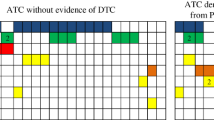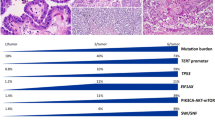Abstract
Background
Recent advances in the treatment of cancer have focused on targeting genomic aberrations with selective therapeutic agents. In radioiodine resistant aggressive papillary thyroid cancers, there remain few effective therapeutic options. A 62-year-old man who underwent multiple operations for papillary thyroid cancer and whose metastases progressed despite standard treatments provided tumor tissue.
Methods
We analyzed tumor and whole blood DNA by whole genome sequencing, achieving 80× or greater coverage over 94 % of the exome and 90 % of the genome. We determined somatic mutations and structural alterations.
Results
We found a total of 57 somatic mutations in 55 genes of the cancer genome. There was notably a lack of mutations in NRAS and BRAF, and no RET/PTC rearrangement. There was a mutation in the TRAPP oncogene and a loss of heterozygosity of the p16, p18, and RB1 tumor suppressor genes. The oncogenic driver for this tumor is a translocation involving the genes for anaplastic lymphoma receptor tyrosine kinase (ALK) and echinoderm microtubule associated protein like 4 (EML4). The EML4–ALK translocation has been reported in approximately 5 % of lung cancers, as well as in pediatric neuroblastoma, and is a therapeutic target for crizotinib.
Conclusions
This is the first report of the whole genomic sequencing of a papillary thyroid cancer in which we identified an EML4–ALK translocation of a TRAPP oncogene mutation. These findings suggest that this tumor has a more distinct oncogenesis than BRAF mutant papillary thyroid cancer. Whole genome sequencing can elucidate an oncogenic context and expose potential therapeutic vulnerabilities in rare cancers.




Similar content being viewed by others
References
Cole MP, Jones CTA, Todd IDH (1971) A new anti-oestrogenic agent in late breast cancer: an early appraisal of ICI46474. Br J Cancer 25:270–275
Rose C, Thorpe SM, Leber J et al (1980) Therapeutic effect of tamoxifen related to estrogen receptor level. Recent Results Cancer Res 71:131–141
Hawk WA, Hazard JB (1976) The many appearances of papillary carcinoma of the thyroid. Cleve Clin Q 43:207–216
Jalisi S, Ainsworth T, LaValley M (2010) Prognostic outcomes of tall cell variant papillary thyroid cancer: a meta-analysis. J Thyroid Res 2010:1–4
Ghossein R, Livolsi VA (2008) Papillary thyroid cancer tall cell variant. Thyroid 18:1179–1181
Soda M, Choi YL, Enomoto M et al (2007) Identification of the transforming EML4–ALK fusion gene in non-small-cell lung cancer. Nature 448:561–567
Shaw AT, Kim D-W, Nakagawa K et al (2013) Crizotinib versus chemotherapy in advanced ALK-positive lung cancer. N Engl J Med 368:2385–2394
Dmanac R, Sparks AB, Callow MJ et al (2013) Human genome sequencing using unchained base reads on self-assembling DNA nanoarrays. Science 327:78–81
Liu X, Tesfai J, Evrard YA et al (2203) c-Myc transformation domain recruits the human STAGA complex and requires TRRAP and GCN5 acetylase activity for transcription activation. J Biol Chem 278:20405–20412
Ard PG, Chatterjee C, Kunjibettu S et al (2002) Transcriptional regulation of the mdm2 oncogene by p53 requires TRRAP acetyltransferase complexes. Mol Cell Biol 22:5650–5661
Wei X, Walia V, Lin JC et al (2011) Exome sequencing identifies GRIN2A as frequently mutated in melanoma. Nat Genet 43:442–446
Avaniyapuram KM, Chongfei Y, Mingzhao X (2012) Mutational analysis of the GNA11, MMP27, FGD1, TRRAP and GRM3 genes in thyroid cancer. Oncol Lett 6:437–441
Guan K-L, Jenkins CW, Li Y et al (1994) Growth suppression by p18, a p16INK4/MTS1- and p14INK4B/MTS2-related CDK6 inhibitor, correlates with wild-type pRb function. Genes Dev 8:2939–2952
Iyer G, Hanrahan AJ, Milowsky MI et al (2012) Genome sequencing identifies a basis for everolimus sensitivity. Science 338:221–223
Hamatani K, Mukai M, Takahashi K et al (2012) Rearranged anaplastic lymphoma kinase (ALK) gene in adult-onset papillary thyroid cancer amongst atomic bomb survivors. Thyroid 22:1153–1159
Ishida E, Nakamura M, Shimada K et al (2007) DNA hypermethylation status of multiple genes in papillary thyroid carcinomas. Pathobiology 74:344–352
Kjelllman P, Lagercrantz S, Höög A et al (2001) Gain of 1q and loss of 9q21.3-q32 are associated with a less favorable prognosis in papillary thyroid carcinoma. Genes Chromosom Cancer 32:43–49
Ball E, Bond J, Franc B et al (2007) An immunohistochemical study of p16(INK4a) expression in multistep thyroid tumourigenesis. Eur J Cancer 43:194–201
van Veelen W, Kompmaker R, Gloerich M et al (2009) P18 is a tumor suppressor gene involved in human medullary thyroid carcinoma and pheochromocytoma development. Int J Cancer 124:339–345
Morris SW, Kirstein MN, Valentine MB et al (1994) Fusion of a kinase gene, ALK, to a nucleolar protein gene, NPM, in non-Hodgkin’s lymphoma. Science 263:1281–1284
Mosse YP, Balis FM, Lim MS et al (2012) Efficacy of crizotinib in children with relapsed/refractory ALK-driven tumors including anaplastic large cell lymphoma and neuroblastoma: a Children’s Oncology Group phase I consortium study. Abstract presented at 2012 American Society of Clinical Oncology Annual Meeting, June 1–5, 2012, Chicago, IL [abstract 9500]
Brose MS, Nutting C, Jarzab B et al (2013) Sorafenib in locally advanced or metastatic patients with radioactive iodine-refractory differentiated thyroid cancer: the phase III DECISION trial. J Clin Oncol 31(Suppl):4
Chapman PB, Hauschild A, Robert C et al (2011) Improved survival with vemurafenib in melanoma with BRAF mutations. N Engl J Med 364:2507–2516
Doebele RC, Pilling AB, Aisner DL et al (2012) Mechanisms of resistance to crizotinib in patients with ALK gene rearranged non-small cell lung cancer. Clin Cancer Res 18:1472–1482
Katayama R, Khan TM, Benes C et al (2011) Therapeutic strategies to overcome crizotinib resistance in non-small cell lung cancers harboring the fusion oncogene EML4–ALK. Proc Natl Acad Sci USA 108:7535–7540
Seto T, Kiura K, Nishio M et al (2013) CH5424802 (RO5424802) for patients with ALK-rearranged advanced non-small-cell lung cancer (AF-001JP study): a single-arm, open-label, phase 1–2 study. Lancet Oncol 142013(14):590–598
Mehra R, Camidge R, Sharma S et al (2012) First-in-human phase I study of the ALK inhibitor LDK378 in advanced solid tumors. J Clin Oncol 30:3007
Sequist LC, Gettinger S, Senzer NM et al (2010) Activity of IPI-504, a novel heat-shock protein 90 inhibitor, in patients with molecularly defined non-small-cell lung cancer. J Clin Oncol 28:4953–4960
Sang J, Acquaviva J, Friedland JC et al (2013) Targeted inhibition of the molecular chaperone Hsp90 overcomes ALK inhibitor resistance in non-small cell lung cancer. Cancer Discov 3:430–443
Boland JM, Erdogan S, Vasmatzis G et al (2009) Anaplastic lymphoma kinase immunoreactivity correlates with ALK gene rearrangement and transcriptional up-regulation in non-small cell lung carcinomas. Hum Pathol 40:1152–1158
Author information
Authors and Affiliations
Corresponding author
Rights and permissions
About this article
Cite this article
Demeure, M.J., Aziz, M., Rosenberg, R. et al. Whole-genome Sequencing of an Aggressive BRAF Wild-type Papillary Thyroid Cancer Identified EML4–ALK Translocation as a Therapeutic Target. World J Surg 38, 1296–1305 (2014). https://doi.org/10.1007/s00268-014-2485-3
Published:
Issue Date:
DOI: https://doi.org/10.1007/s00268-014-2485-3




